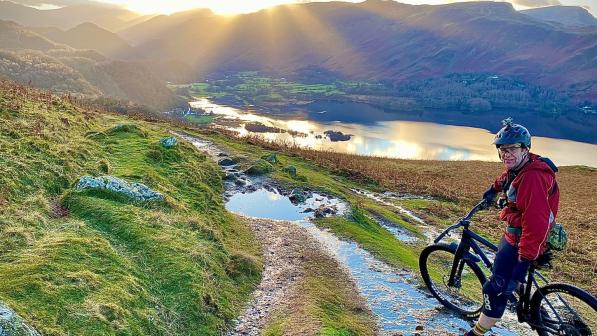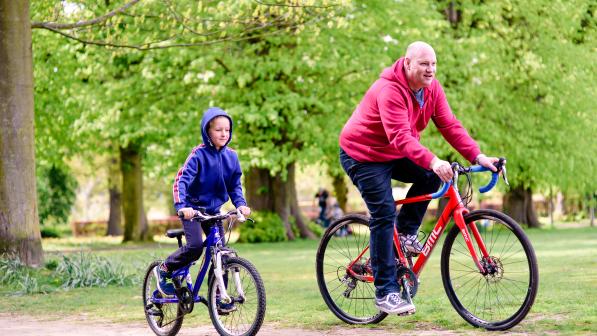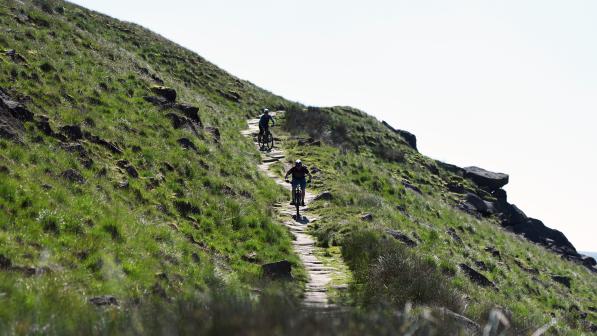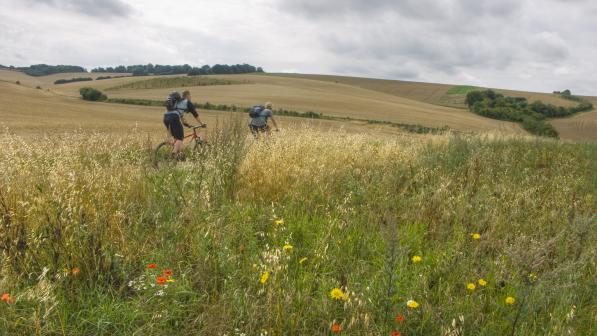Local campaigners a step closer to turning a footpath into a bridleway
What just happened?
One of our local groups took on the challenge of claiming a route as a bridleway based on 20 years of uninterrupted use by cyclists. The application was initially rejected by the council, but with support from Cycling UK the group have successfully appealed the decision, bringing them a step closer to winning the legal right to use the route.
What was the problem and how could it be solved?
Cyclists had been using a path through an estate for many years that was recorded as a footpath, even though in fact it was a well surfaced estate road. This had never been a problem, but a few years ago the landowner erected gates and then later put up signs saying no cycling.
However, there is a mechanism available for the public to claim a route as a public right of way, if they can prove that people had been using it for 20 years without being challenged.
Who was working on it to start with?
The applicant, Reg Oakley, had been a CTC Right to Ride representative / Cycling UK local campaigner for his area for many years, and rode with local groups regularly.
What did they manage to achieve?
Well, firstly, they took on the challenge, and the importance of that cannot be underestimated.
Many riders feel that the rights of way system is so stacked against us that it’s not worth bothering, so it would perhaps have been easier for this group to shrug their shoulders and find another route (or, as some might, just carry on riding it regardless).
Instead they looked at what they needed to do to get the status of the route changed for future generations and the local members filled in user evidence forms, recording their use of the route over many years, and formally claiming the route as a bridleway based on more than 20 years of uninterrupted use.
How did Cycling UK get involved?
Fast forward a few years and the local council got round to processing the application, but said that because the landowner had submitted paperwork to them in 2007 (without putting up the signs) the claim was invalid.
At that point, Reg contacted us at head office asking for help, and we plunged into the paperwork in order to appeal the council’s decision and get the application through to the next step.
Why was the application initially judged to be invalid?
In 1950, when the first rights of way maps were being drawn up off the back of the 1949 National parks and access to the Countryside Act, the route was recorded on the parish maps, probably by local parish councillors, as a “Cart Road Footpath” (a status that, like Cart Road Bridleway, later became ‘road used as public path’) and as having a metalled surface, with sign “private road, footpath only” at the entrance.
At some point before the publication of the Draft Map, “Cart Road Footpath” got amended to “Footpath”. Historic records have shown that in some areas this was done under pressure from powerful local landowners, and on others by the council to reduce their own maintenance liabilities. Unfortunately, the errors of the past are very difficult to put right now.
Since then, very little seems to have happened until 2007, when the landowner deposited a document with the council saying that no new rights of way would be created on their land (this, under section 31(6) of the act would protect them from users subsequent claiming new rights of way, but not defending them against historic claims).
We have evidence forms from riders saying that they have, however, been riding their bikes along the route since at least the 1970s, and were not challenged until signs went up in 2015.
The key issue then becomes what happened in 20 years prior to the deposit, and whether anything has been done to demonstrate to the public that they were not allowed to use the route. However this is where this case got tricky, the council wanted to count the 20 years back from the erection of signs in 2010, rather than the 2007 deposit. and that’s where we believed they had made a mistake.
How did Cycling UK appeal the council’s decision?
Luckily, there are people like me who read rights of way caselaw for fun and I recognised there was a piece of House of Lords caselaw that set out, in principle at least, that the council were in the wrong, so we appealed the decision. Doing this involved setting out an extensive legal submission based upon previous caselaw on the issue, and we had to complete it within the tight timescales for appeal.
What are the next steps now?
Well, winning this appeal is the first big battle, but there’s another to come. The process is remarkably longwinded: from here, the local authority has to publish an order, creating a new bridleway, but that order can be objected to before confirmation.
If the landowner objects then the whole thing will probably go to local public inquiry - where a planning inspector will hear the case, essentially as a judge, and both sides will be allowed to call witnesses for evidence and cross examination. Only at that point will a final decision be made.
How will this benefit people if it succeeds?
Well, the first benefit will be to the local riders who will be able to continue using their chosen route - but it’s also important to consider that the route connects to the North Downs Way National Trail, so there would be a nice, circular, almost traffic free, route for local kids to ride on.
Any advice for people campaigning on similar issues?
I think that the key lesson is that the system, though longwinded, works - footpaths can be successfully upgraded to bridleways based on (generally) 20 years of unchallenged public use.
I’d like to emphasise here that this is the way the rights of way system is supposed to work. It’s supposed to reflect changes in society, not be preserved as it was a century ago. The mechanism for us claiming upgrades is exactly the same mechanism by which the Ramblers and other organisations have claimed routes for decades, that a path has been used by the public (often as a form of trespass) for so long that it becomes a public right.
Now, if we think about how long ago mountain biking started becoming popular in the UK, that means that right now we probably have thousands of routes that people have been riding without a problem for years, but could get together with other riders and claim in order to record the route in perpetuity.
We need people to get active, get talking to each other and get claiming - some groups like Peak District MTB have already started off in the direction of doing this - and upcoming changes in the rights of way claim process will make things simpler. So now it the time to start looking at your local area and thinking about when you started riding certain routes, and speaking to others about making a claim.



